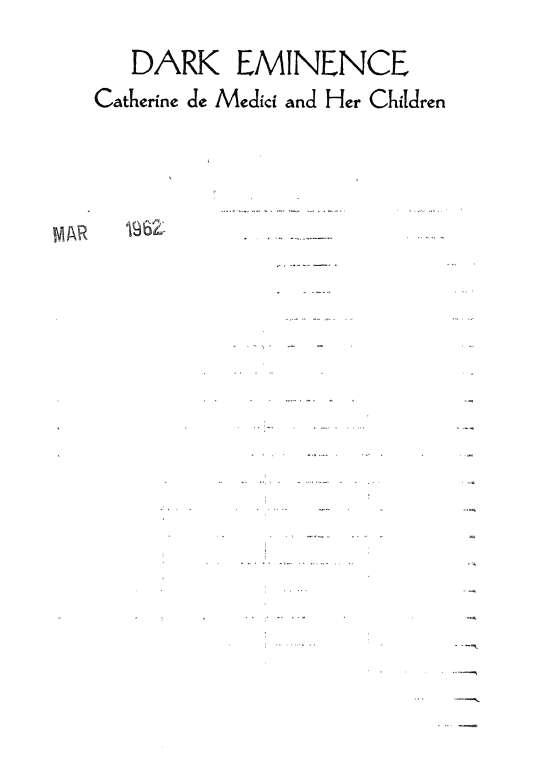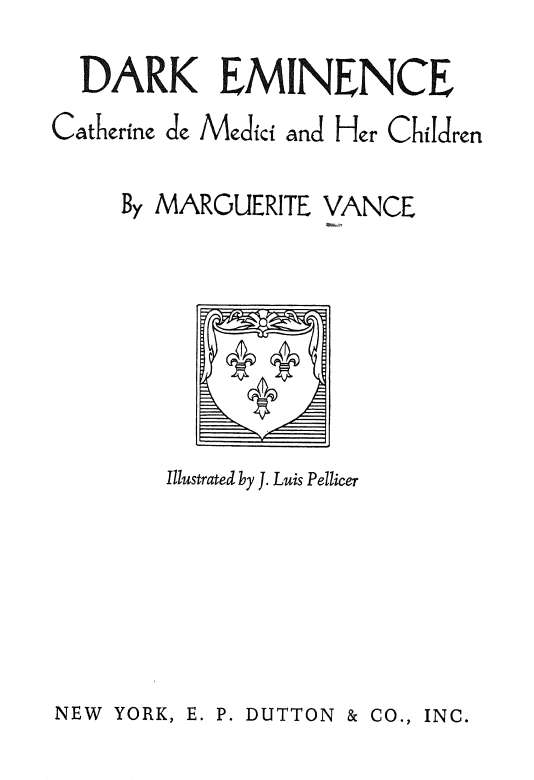Dark Eminence Catherine De Medici And Her Children
Read Dark Eminence Catherine De Medici And Her Children Online
Authors: Marguerite Vance







Copyright, ©, 1961 by Marguerite Vance All rights reserved. Printed in the U.S.A.
FIRST EDITION
No fart of this hook may he reproduced in any form without permission in writing from the publisher, except hy a reviewer who wishes to quote hrief passages in connection with a review written for inclusion in a magazine, newspaper or hroadcast.
Published simultaneously in Canada hy Clarke, Irwin & Co., Ltd. of Toronto
C 3 L ~c \r
For Betsy and Ellen Davey
_ ^ Adalt
.:;"u4^3
Acknowledgment
Acknowledgment is made as follows for help in preparing the manuscript: Burton, Elizabeth, THE PAGEANT OF ELIZABETHAN ENGLAND.
New York: Charles Scribner's Sons, 1959. DuPrat, A. T. HISTOIRE D'ELIZABETH DE VALOIS, REINE
DESPAGNE. Techner, 1859. Freer, Martha Walker. ELIZABETH DE VALOIS, QUEEN OF SPAIN.
2 vols. London: Hurst & Blackett, 1857. Hume, Martin A. S. LIFE OF PHILIP n OF SPAIN. New York:
Burt, 1928. Norris, Herbert. COSTUME AND FASHION. Vol. 3. New York:
E. P. Dutton & Co., Inc., 1939.
Roeder, Ralph. CATHERINE DE' MEDICI AND THE LOST REVOLUTION. Garden City, N. Y.: Garden City Publishing Co., Inc., 1939.
Van Dyke, Paul. CATHERINE DE' MEDICIS. 2 vols. New York: Charles Scribner's Sons, 1922.
Young, George F. THE MEDICI. New York: The Modern Library, Inc., 1930.
Waldman, Milton. BIOGRAPHY OF A FAMILY; CATHERINE DE MEDICI AND HER CHILDREN. Boston: Houghton Mifflin Co., 1936.
Watson, Francis. THE LIFE AND TIMES OF CATHERINE DE' MEDICI. New York: D. Appleton-Century Co., Inc., 1935.
Contents
House of Medici
LORENZO
(1492-1519) Duke of Urbino
MADELEINE ra LA TOUR D'AUVERGNE
CATHERINE DE MEDICI
(1519-89) Queen of France
L

FRANCIS II
(1 543-60)
King of France
-MARY STUART
Queen of
Scotland
House of
Guise
CLAUDE
(1547-75)
Duchess of
Lorraine
- CHARLES
Duke of
Lorraine
House of
Guise
ELIZABETH
(1545-68) Queen of Spain
• PHILIP II
King of Spain
House of
House of Valois
FRANCIS I
(1494-1547) King of France
HENRY II
(1519-59) King of France
I
CLAUDE daughter of Louis XII
House of Bourbon
MARGUERITE
(1552-1615)
Queen of
France
Foreword
I HAVE not the temerity to undertake a comprehensive "life" of Catherine de Medici, but I have tried in this light sketch of her life and the lives of her children to round out at least a full-length portrait of each.
Again, I have tried to keep the narrative as much as possible within the boundaries of their family life. The era in which they lived was one of unrestrained debauchery and extravagance on one side and fanatical austerity on the other, the whole meshed in a welter of complex political and religious entanglements far beyond the interest of the average young reader.
Some of the Valois children were not especially attractive young people, yet they were assigned important—though small—roles in the drama of the Renaissance. So it is my hope that in this book they may emerge as individuals who were consistent in their work in those roles.
MARGUERITE VANCE
December 18, 1960
DARK EMINENCE
Catkerine de Medici and Her Children
Chapter 1 FIRST DREAMS

AT AN upper window in the royal cMteau at Blois a young girl sat looking out across the moat to the shimmering woods beyond. It was mid-August in 1536. Heat in damp waves rose above the moat, drifting in at the open casements, white sunlight beat down upon the battlements as though in a kind of astringent fury at the sharp black shadows they cast. Off to the east, rising above the treetops, storm clouds the color of ripe figs moved in unhurried certitude. At long intervals, a white sliver of lightning punctuated the slowly tumbling mass and thunder muttered halfheartedly.
Inside, the air was heavy with the scent of patchouli and lemon and with the all-pervading odor of sweat-drenched velvet and brocade, for royalty refused to yield fashion to the whims of the weather.
The girl beside the window wore a French hood of black
velvet and white satin drawn down behind her ears, leaving her abundant wavy light-brown hair to frame her face on either side. Her eyes were dark and enormous; some historians have called them green, but they probably were that odd cloudy hazel so characteristic of the Medicis. Otherwise, her face rising above the jeweled bodice of her rose velvet and brocade gown was the round, rather formless face of a healthy child. Only the eyes and the full sensuous lips betrayed her as the daughter of Lorenzo de Medici, usurping Duke of Urbino.
She was just seventeen years old, and within the hour she had learned she was no longer merely the Duchess of Orleans. Her husband's brother, the Dauphin, had died in the night and Henry, her solemn, humorless yet greatly loved husband was now Dauphin and would one day, God willing, be King. She, Catherine de Medici, would be Queen of France.
For a moment she closed her eyes, with her large cambric handkerchief dabbed at the perspiration beading her upper lip. Some things one must learn to accept, the thought tumbled through her consciousness, but how did one ever learn to reconcile false testimony and the terrible death of an innocent man with royal prerogative? That her brother-in-law had died of pleurisy brought on by drinking ice-cold water after playing tennis she knew; yet one Count Sebasti-ano di Montecuculli under torture had been made to swear he had been hired by Emperor Charles V of Germany to poison the King and the Dauphin, but had succeeded only in killing the Dauphin. Something, some ingredient in the
amalgam of royal behavior was in itself poisonous, Catherine's conclusions argued, else why had her own seventeen years been so weighted with misery? How was she, with the other ladies of the Court, going to be able to face Montecu-culli's death, "torn by horses," as she had faced so many other hideous executions during her three years in France? Seated in the royal pavilion, laced into smothering folds of brocatel and cloth of gold, one retched quietly behind one's handkerchief, hearing the shrieks of the dying as the burnings and beheadings and tearings proceeded. One did not faint or beg to be excused; gradually, across the years one learned to accept, even to rationalize the horrors as expedient.
Catherine was born on a rainy April morning in 1519 in the Medici palace in the via larga in Florence at a time when her young father, Lorenzo, was dying of tuberculosis.
Madeleine de la Tour d'Auvergne, Catherine's lovely young French mother, died when her little daughter was twelve days old, and Lorenzo a fortnight later, so before she was a month old, Catherine de Medici was an orphan. Naturally, it meant nothing to the baby that one day she would be queen and regent of one of the greatest nations of the world, that she would be the mother of three kings, two queens, a sovereign duke and a reigning duchess.
Her first six years were spent in Rome, doubtless under the watchful eye of her uncle, Pope Leo X. Then she was brought back to Florence to live for a time with her aunt and uncle, Filippo Strozzi, one of the wealthiest nobles of the city. But it was a time of great political unrest in Florence. Catherine's cousin, Ippolito, a great favorite with the Pope,
had teen made il Magnifico and given all the power that title entailed.
The year 1527 was a disastrous one for the Medici family. Emperor Charles V of Germany, who was also King of Spain, stormed Rome; in Florence the Italian people rose in bitter protest against Ippolito's highhanded methods as head of the Medici. The very name Medici became anathema and grizzly outrages were perpetrated against bearers of it in the name of justice. Little Catherine had been in hiding in a nearby villa. Now she was brought into the city once more and put into the care of the Dominican nuns in the convent of Santa Lucia. A few months later she was transferred to the convent of Santa Caterina of Siena, then to the convent of Santissima Annunziata delle Murate. In 1528 when her aunt died, the nine-year-old child realized with a sinking heart that, though comparatively safe in the convent, she was alone in a city filled with enemies of her House.
Many of the nuns were faithful adherents of the House of Medici and were discovered by the victorious enemy to have carried food to Medici prisoners. To the horror of the good women, they learned that cruel reprisals were to be meted out upon their little charge, so again she was spirited away to the convent of Santa Lucia. Bewildered, certain of nothing but that, in spite of the great deference shown her, she was a refugee, Catherine kept her own counsel and tried to adjust to the routine of Santa Lucia.
Her uncle, Pope Leo X, had died and had been succeeded by her grandfather s cousin, Pope Clement VII, and he now ordered the little Duchessina to be brought to Rome to live

with her aunt, Lucretia Salviati He could not permit so enormously rich a young kinswoman to live so far removed from his surveillance. Rome seemed the proper place for her. He and Francis I of France had been negotiating since Catherine was six years old for a marriage between her and the King's second son, Prince Henry, Duke of Orleans.
The Venetian ambassador writing of Catherine in 1532 when she was thirteen, said, "The little Duchess is of a rather vivacious nature but shows an amiable disposition. . * . She is small and thin, her face Is not refined, and she has the big eyes which belong to the family of the Medici/' One wonders what the ambassador meant by her face not being "refined/' Possibly the heavy Medici lips offended him. In later life Catherine was often described as "magnifi-
]g Dark Eminence
cent/' "superb," and "impressive/* but never as beautiful, so probably even in early childhood she was not pretty.
Plans for her marriage to the Duke of Orleans had been progressing slowly, for the dowry demanded by the King of France was unreasonable and the sum finally settled upon, after much haggling, was far less than France had been led to expect. By August, 1533, however, the royal trousseau was well under way. On September second Catherine gave a farewell banquet to the ladies of Florence at the Medici palace and received from them hangings for her apartments made of cloth of gold embroidered with pearls. Considering the price of one fine pearl and one ell of cloth of gold, the gift, one must judge, was priceless.
Touched more than she dared admit even to herself, Catherine made her formal speech of thanks while her throat ached and her eyes Warred. Then her gentlemen lifted her up on her prancing, richly caparisoned hackney and she rode out under the ancient arches of Florence for the last time. The night was spent at Poggio a Caiano, then, escorted by relatives among the Florentine nobility, she continued on her way to Spezia where she was met by her uncle, the Duke of Albany, with a fleet of sixty ships.
She embarked on the royal galley, a magnificent craft built at fantastic cost. As one historian describes it:* "The state salon extended from the mainmast to the rudder, covered with the richest crimson damask strewn with golden lilies trailing down profusely in long folds almost to the sea.
